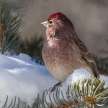
Quebracho Crested-Tinamou is an endemic Chaco that is restricted to a small region in west Paraguay, southeastern Bolivia that is northern Argentina, where thick thorny woodland and surrounding savanna occur in arid regions. Biology of this species is little known but early observations on the field suggest significant distinctions between it and the more widespread and well-studied Elegant Crested-Tinamou with which it forms a superspecies. Mostly in browner dorsal colouration, bolder breast marks and less heavily coloured underparts it varies from the species. Sub-specie E. f. Mira, described for the Paraguayan population, is dubiously valid and most modern authorities consider the species monotypical. It is not currently recognised whether Quebracho Crested-Tinamou is under any threat to life, but increasing habitat loss within the species range indicates that it may qualify for an endangered status in the near future. Tinamous are stormy, with very short tails, small legs, and rounded wings. The two crested-tinamous species (Eudromia) are large tinamous with a long thin crest on the back of the crown, and just three toes (the hallux lacquer). Sprinkled with cream, Crested-Tinamou Quebracho has greyish brown to blackish upper parts. The underparts are often whitish to light buffy, lined, and vermiculated with grey. There is also a long whitish line starting at the base of the bill and continuing past the eye and down the leg of the body. Brushland Tinamou is the most potentially confusing species in the region over most of the Crested-Tinamon Quebracho range. Yet Brushland Tinamou is usually solitary (as opposed to the social Quebracho Crested), lacks a banded head pattern and has a black topknot, not a small, fluffy crest. The superficially similar Elegant Crested-Tinamou is allopatric because this species extends the range of the northern subspecies magnistriata in Santiago del Estero. Short compared the two and distinguished Quebracho Crested by being whiter ventrally, with a stronger barred upper breast bound by dark shaft streaks and with a browner dorsum exhibiting delicate vermiculations, many bands and large buff spots as opposed to grayer with smaller, more regular spots in magnistriata. Formosa's outer primaries on the inner vane are unbarred, or generally display subtle barring signals, while magnistriata are heavily barred primaries. The adult has a thin crown, like a beard, with flat, short black feathers. Grayish brown on top and vinaceous buff on the bottom, more or less heavily mottled and vermiculated black with occasional ochraceous spotting and neck-and-rump freckling. Crown, hind collar, malar, and deep ochraceous brown auriculars, streaked with black shaft stripes. Broad white lines stretch above and under the auriculars and spread to the sides of the neck. Grey-faced. External primary fuscous with external webs notched uniformly with immaculate buffy-white and internal webs, or indistinctly spotted or vermiculated with buff. Near main interior except the internal chains of scattered ochraceous vermiculation. Ochraceous to medium vinaceous, grey foreneck and chest with black sagittate marks on the breast and arms increasing in size and strength. Abdomen, crissum, creamy-white to ochraceous-buff on the sides and flanks. The diet of Quebracho Crested-Tinamou is unrecorded, but birds appear early in the morning and late in the afternoon on roads where they can be seen picking on substrates in the manner that Bohl defines for Elegant Crested-Tinamou. The items they bring are not clear to the naked eye, but it is understood that Elegant Crested drinks grit every day, and this is an analogous activity indeed. Elegant Crested-Tinamou, which grows further south in similarly arid conditions, metabolically serves its water requirements from the plant matter in their diet and the same may be true for this genus. Vocalizations take place all day, most frequently early in the morning and late in the afternoon, frequently beginning before sunrise and continuing until sunset. The animals sometimes sing all night long.
About the Creator
MB
I am a bird aficionado and really enjoy spotting them them on hikes. I greatly appreciate the variety of birds cross North America and the world. They are amazing and intelligent creatures, each so unique and with a wonderful life.






Comments
There are no comments for this story
Be the first to respond and start the conversation.